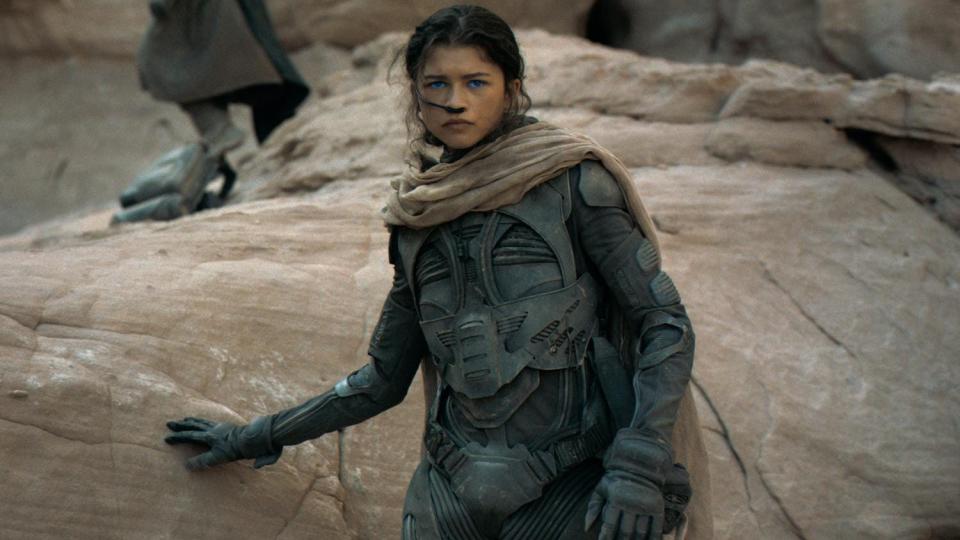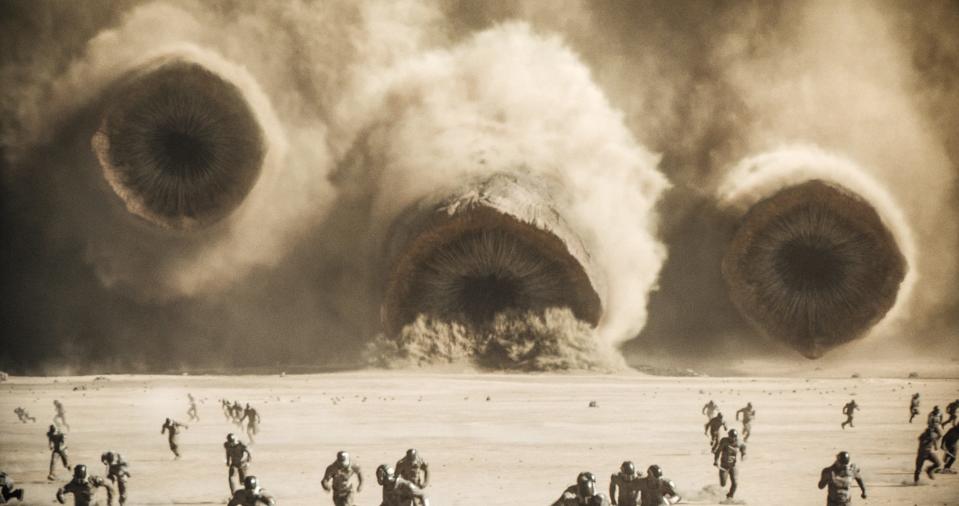-
The desert planet of Arrakis in “Dune: Part Two” has extreme temperatures and little water.
-
Surviving on such a planet would require technology and adaptability.
-
Three experts explain what it might be like to live on planet Earth.
In a distant star system, 20,000 years in the future, a hot planet with barren deserts and little water is inhabited by blue-eyed seminomadic inhabitants called the Fremen.
Frank Herbert first described this harsh, fictional world of Arrakis in his 1965 novel “Dune,” which was recently adapted into a film trilogy. The second iteration of the trilogy “Dune: Part Two” debuted in US theaters on Friday.
The film was shot in the deserts outside of Abu Dhabi, but we didn’t know what it would really take to live on Arrakis in real life.
Although it would require some ingenuity and technology, it would not be impossible, according to the scientists we spoke to.
“There are populations that have lived for hundreds of years and even thousands of years in the desert,” Seth Collings Hawkins, a desert medicine specialist with the Wake Forest University School of Medicine, told Business Insider.
What Dune’s planet would look like in real life
“There are so many factors that make Earth habitable for humans,” Amy J. Kreykes, an aerospace medicine expert at the University of Texas Medical Branch, told BI.
That includes everything from the atmosphere to its distance from the sun to the water available to it.
“Everything is perfect and unique,” she said, “and in fact any departure from any of the other environments could be a hostile environment for people.”
The Dune planet of Arrakis has giant sandworms, a drug called spice that aids interstellar travel, and two moons. But it is not entirely unlike Earth.


When “Dune: Part One” came out in 2021, University of Bristol meteorologist Alexander Farnsworth and several other scientists used a climate forecast model to simulate Arrakis conditions.
They entered everything they could find from The Dune Encyclopedia on the planet’s geography, atmosphere, and astronomy.
There were some places where the team’s model differed from the book’s description, such as the weather at the poles and the tropics of the planet, for example.
Overall, however, Farnsworth said he was impressed with the world Herbert created.
“I think the thing that surprised me the most overall was how accurate Frank Herbert was when he was looking at a desolate world without a background in physics or a supercomputer to do any kind of calculations on it,” he said.
“He must have done a lot of research on the various components of the world system to understand how such a world could work,” he said. In fact, Herbert said he spent six years researching the book.
Based on their calculations, Farnsworth and the other researchers found that it is possible to live on Arrakis, although it is unlikely to be that pleasant.
Persistent lack of water


The planet Arrakis has no oceans, lakes, or even small ponds on its surface. Needless to say, that’s bad news for people.
“There is a rule of threes,” Hawkins said. The human body can go for about three minutes without oxygen, about three days without water, and about three weeks without food. “This was the point at which your body would start to break down,” he said.
To survive those dry conditions on the Dunes, the fictional Fremen wear what are called stillsuits, which capture the body’s perspiration and other bodily fluids and turn them into drinkable water.
However, this is not quite a sci-fi concept.
Hawkins called space the “ultimate water-deficient environment,” which is why the International Space Station’s toilets turn nearly 85% of astronauts’ urine into drinking water.
Reclaiming moisture is essential in environments where there is no ready external source. However, as vital as water is, on Arrakis, the real killer is temperature.
“You would probably get heat stroke before you die of dehydration,” Hawkins said.
The extremes of temperature that survive


Contrary to the book, Farnsworth’s scientific model of real-life Arrakis found the tropics to be more hospitable than the polar regions because the temperatures would be milder year-round.
At the poles, temperatures ranged from 158 degrees Fahrenheit in the summer to -76 degrees Fahrenheit in the winter. Meanwhile, temperatures in the tropics would range from 56 to 113 degrees.
“So [at the poles] not only heat stress but also cold stress that living things would have to deal with,” on real-life Arrakis, he said.
Therefore, if you could pick, you would live near the equator on Arrakis.
“The most feared consequence of being out in that environment is heat stroke, which literally cooks the brain,” said Hawkins. The body temperature would rise to 106 or 107 degrees Fahrenheit, hotter than a fever.


“You wouldn’t be traveling during the day at all,” he said. Everyone would take shelter until the temperature started to cool at night. In case you have to go out during the day, you would need something like a relaxed outfit.
“It seems paradoxical [to cover yourself]but we now know that much of the problem is radiation and heat exposure from the sun,” Hawkins said.
Certain fabrics are breathable and good at reflecting heat. Integrating heating materials with clothing can help, but you’d still need an internal fan or some kind of air conditioner, Hawkins said.
“With technology, we can add actual tools that help extend our time out in the sun or in the hot environment with fewer ill effects,” Hawkins said.
The atmosphere that lasts


When it comes to the composition of the atmosphere, “people are very specific in their needs,” said Kreykes.
The atmosphere on Arrakis is similar to Earth. It has similar pressure, slightly less nitrogen (74.32% compared to about 78% on our planet), and slightly more oxygen (23.58% compared to Earth’s 21%).
Despite the similarities, people may still have an adjustment period.
“Anytime you start messing with the atmosphere and changing those parameters, it could have significant effects on humans,” Kreykes said. “Any event must be looked at very closely for human habitability.”
Arrakis also has slightly less carbon dioxide than Earth, which can affect plant growth. Another challenge would be on top of the limited water sources.
A glimpse of the future Earth?


While learning how to tame a giant sandworm is a problem that Earth will never have to face, parts of our planet are no different from Arrakis.
For example, the Sonoran Desert along the Mexico-US border recently hit 177 degrees Fahrenheit, one of the hottest surface temperatures on record.
Arizona, New Mexico and California have faced droughts or water shortages in recent years.
As the Earth continues to warm in the face of climate change, excess heat and water scarcity will continue to affect not only humans but plants and animals around the world.
One reason for the popularity of “Dune” and similar speculative fiction, Hawkins said, is because we see elements of our own future in it, “and I think this story has that message for us.”
Read the original article on Business Insider